All products featured are independently chosen by us. However, SoundGuys may receive a commission on orders placed through its retail links. See our ethics statement.
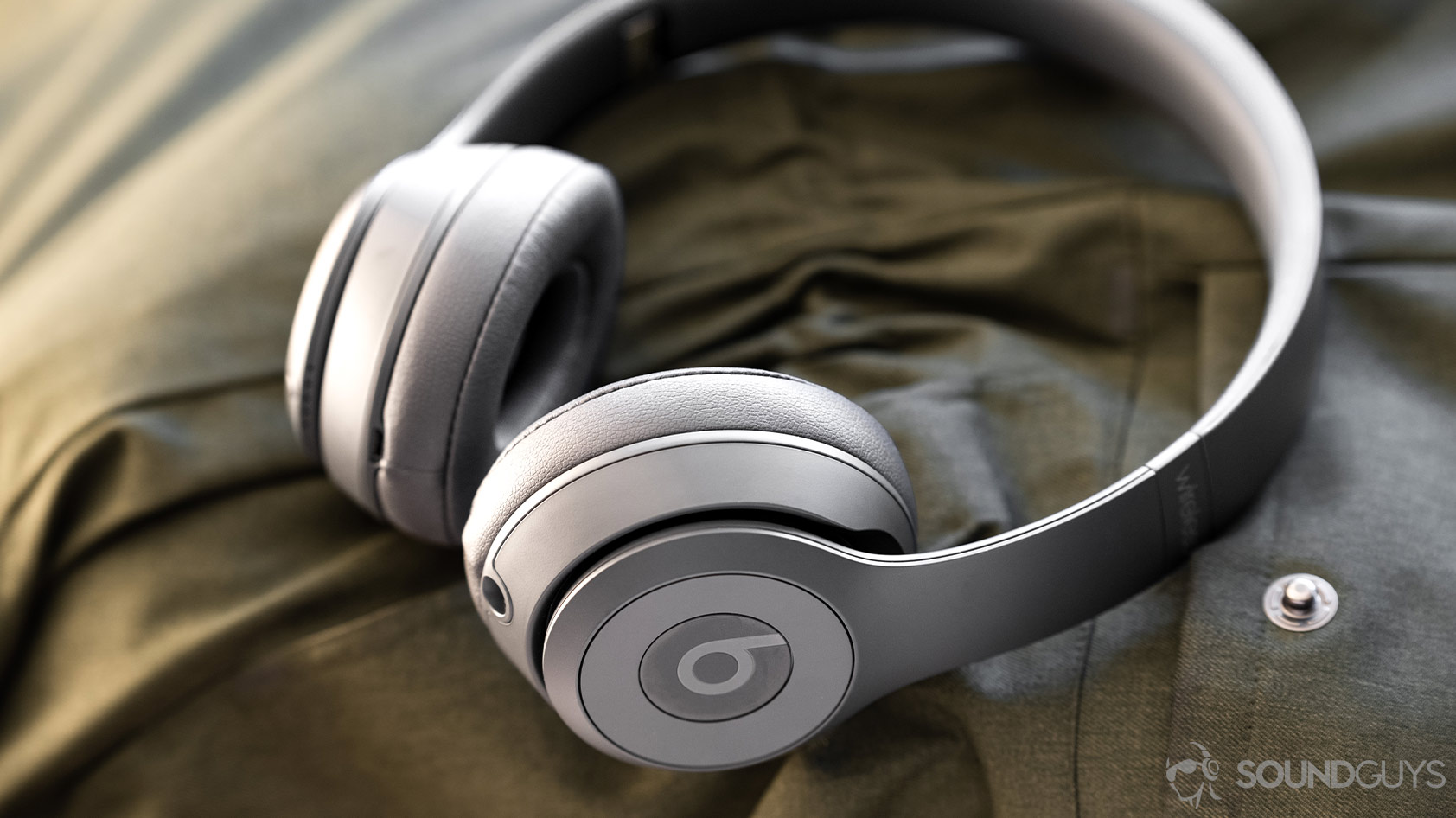
Beats Solo3 Wireless review
August 8, 2024
Beats Solo3 Wireless
Beats, an Apple subsidiary, has historically determined what’s fashionable among consumer audio products. Its Beats Solo3 Wireless may be a few years old, but the on-ear aesthetic could easily fit into the company’s modern lineup. If you don’t need the latest and greatest features, the Solo3 will serve you well with its W1 chip integration, fast charging, and exceptionally long battery life.
We’ve spent two weeks with the Beats Solo3 Wireless to better inform you if it’s good for your needs.
Editor’s note: this Beats Solo3 Wireless review was updated on August 8, 2024, to update outdated data.
iPhone owners will benefit from the W1 chip of the Solo3, though it’s not quite as efficient as the newer H1 chip. What’s more, AAC support ensures reliable high-quality streaming on iPhones, iPads, and Macbooks.
Fashion-conscious listeners will enjoy the subdued design of the Beats Solo3 Wireless. This headset is available in a wide variety of colors, guaranteed to scratch your style itch. The on-ear design may not be the most comfortable, but its low profile compliments almost all outfits.
What’s it like to use the Beats Solo3 Wireless?
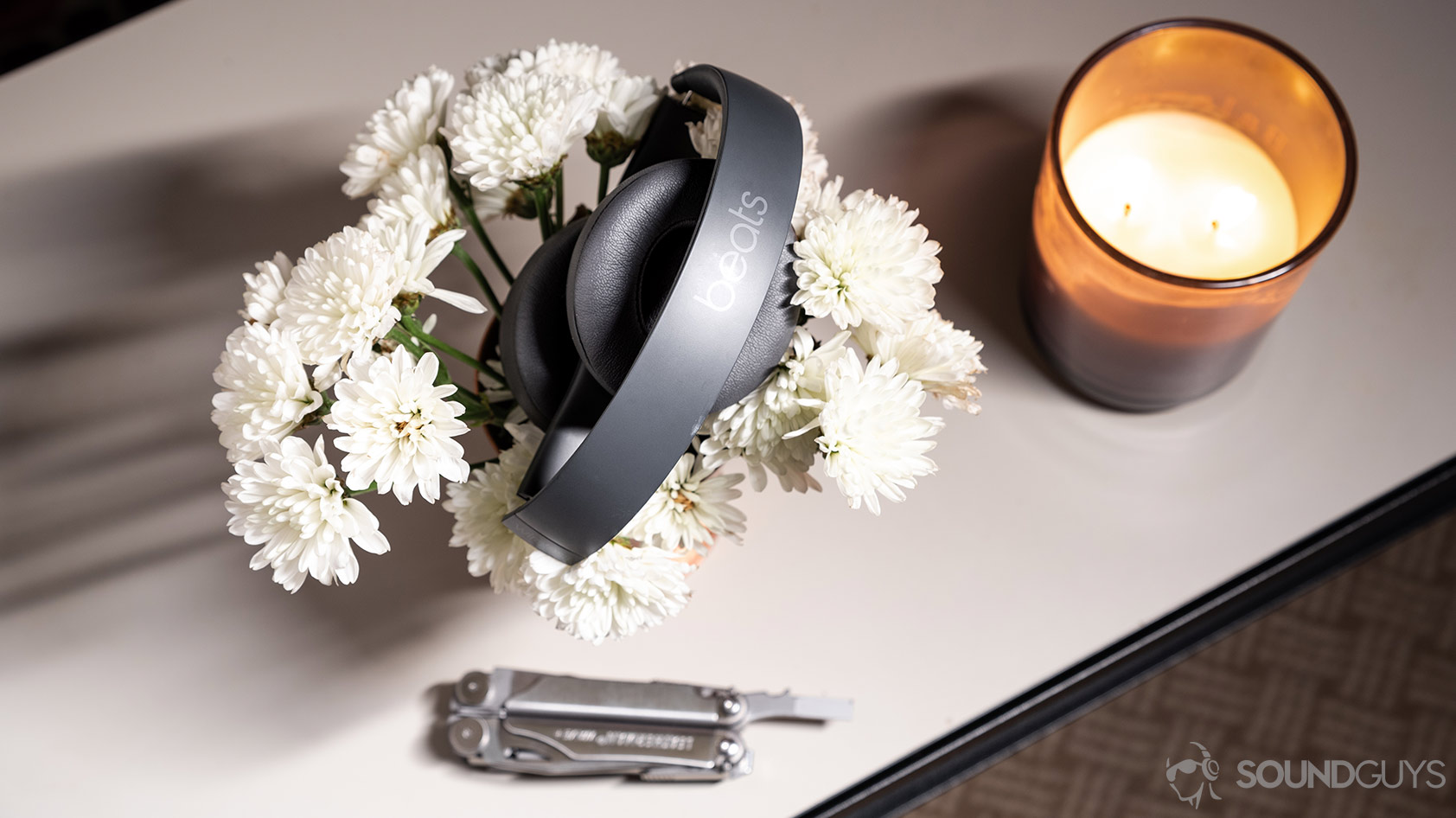
The Beats Solo3 Wireless is akin to other Beats headphones. Our original review unit featured a glossy black finish, which proved a fingerprint magnet. However, our current matte-grey model effectively resists oil smudges but remains easily scuffed. The hard plastic seems durable enough, but the hinges and headband flexibility are cause for concern. A pleather material hugs the foam ear pads, making these a fine option for vegans.
Clamping force may pose an issue for listeners prone to tension headaches: by nature of the on-ear design, an undue amount of pressure is placed on the ears to isolate the listener from their surroundings and keep the headset in place. If you wear glasses, do yourself a favor and skip on-ears altogether. You’ll be much more comfortable with earbuds or over-ear headphones.
The Beats Solo3 Wireless gives listeners the liberty to choose between wired and wireless listening.
Beats include a few accessories with its Solo3 Wireless; you’re afforded a soft zippered carrying case with a carabiner, 3.5mm aux cable, and micro-USB charging cable. Yes, these headphones precede Apple’s push for its proprietary Lightning cable. The zippered case is an okay inclusion and great for anyone with limited bag space as you can just hook it on externally, but if you actually want to protect the Solo3 Wireless, get a hardshell case.
How do you control the Beats Solo3 Wireless?
The Beats Solo3 Wireless includes a 3.5mm input for your headphone jack. Assuming you have a compatible smartphone, you can enjoy high-quality wired audio with ease. When listening in wired mode on an Android phone, the cable controls are ineffective, and you won’t be able to adjust the volume or control playback, which you can still do from an iPhone and wired connection. Below are the controls when listening wirelessly.
| Single press | Double press | Triple press | Press and hold | |
|---|---|---|---|---|
"b" button | Single press Play/pause, answer/end call | Double press Next track (hold on second press to scan forward) | Triple press Previous track (hold on third press to scan backward) | Press and hold Reject call, activate voice control |
Above "b" | Single press Volume up | Double press | Triple press | Press and hold Increase volume continuously |
Below "b" | Single press Volume down | Double press | Triple press | Press and hold Decrease volume continuously |
How do you connect the Beats Solo3 Wireless to an iOS or Android device?
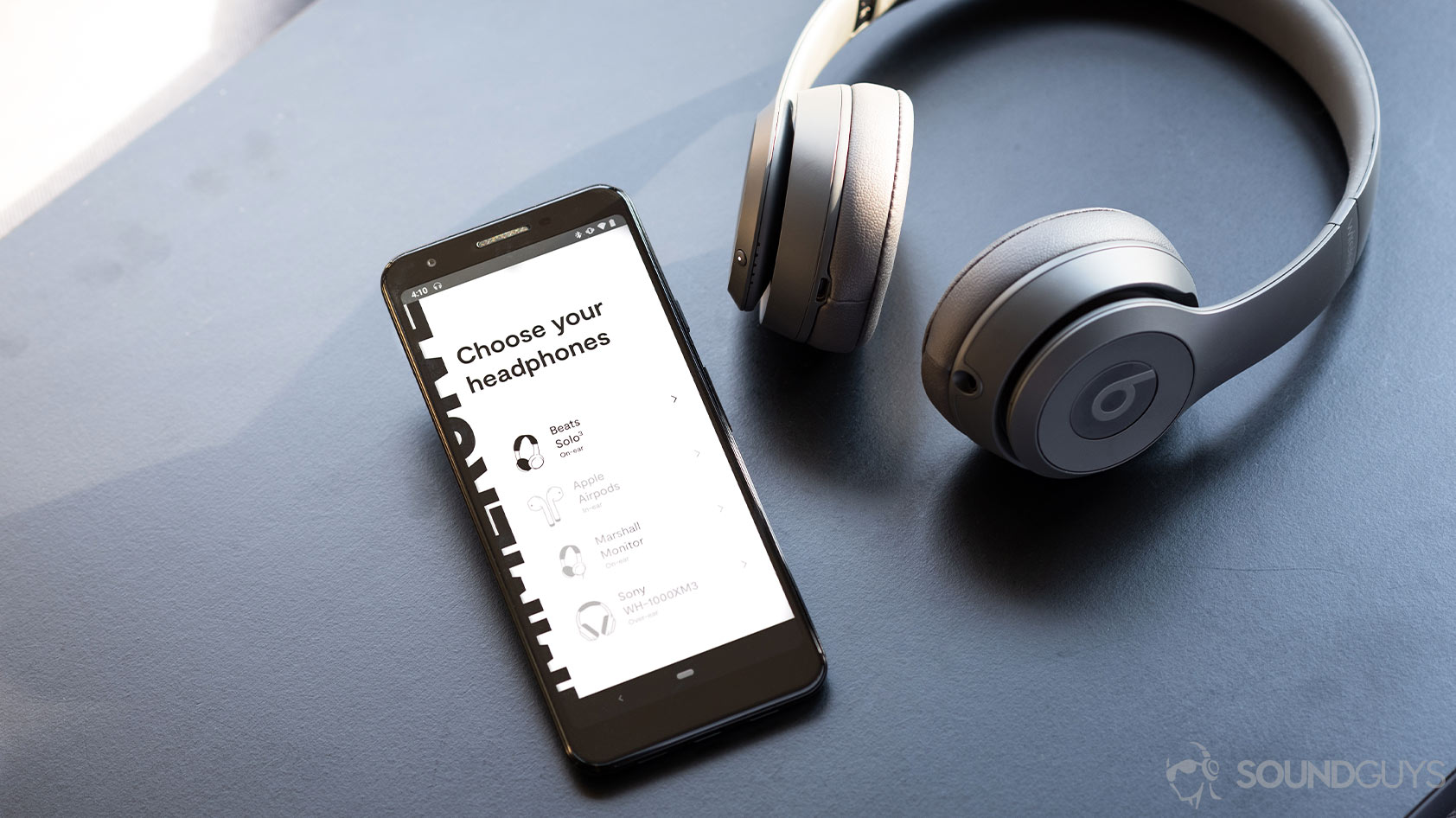
The W1 chip is programmed to immediately communicate with a nearby iOS device. When you initially power the headset on, a pop-up card will prompt you to pair the Solo3 Wireless to your iPhone. Once a connection is established between the two devices, all of your other iCloud source devices will recognize the Beats Solo3 Wireless. This same chip also gives the wireless range a huge boost. If the phone is in your pocket or backpack, you won’t have an issue at all. We can get to around 30 meters easily without skipping at all.
While quick pairing was initially only supported on Apple devices, the Beats Solo3 Wireless now also supports fast pairing on Android. A card will pop up on your Android device when you power up the headphones, enabling you to connect the headphones to your device with a single tap.
The headset supports AAC for high-quality streaming on iPhones. If you have an Android, you’re better off forcing SBC streaming, as AAC’s performance is a bit inconsistent across non-iOS devices. Then again, you could always reach for that included headphone cable, too.
How long does the battery last on the Beats Solo3 Wireless?
Our battery testing yielded an incredible 45 hours and 8 minutes of playback before the headset was drained. As if this weren’t impressive enough, the Beats Solo3 Wireless Fast Fuel technology is remarkable: just five minutes of charging supplies approximately 180 minutes of playtime. This is great for listeners in a pinch and is sure to get you through a round-trip commute to and from work.
If you’re on iOS, there is a handy battery widget that you can add in the widgets section of your phone in order to keep track of the battery life of all of your connected devices. If you don’t feel like pulling out your phone every time you want to check the battery life of your Beats Solo3 Wireless (or if you’re on Android), there’s another simple way to check battery life as well. Simply press and release the power button, and it will light up the LED lights corresponding to how much battery is left.
How well does the Beats Solo3 Wireless block noise?
Loading chart ...
Since these are on-ear headphones, isolation is just okay. High-frequency noises are well-tempered, but low-frequency noise, like a jet engine, can easily cut through the Solo3 Wireless. When you wiggle your ears or even move your head, you may displace the headset a bit, which will only worsen the isolation. If you want more effective isolation but like the look of on-ears, you may want to consider over-ear headphones or hunt around for the Beats Solo Pro. The Solo Pro has an exceptionally strong clamping force, which was too painful for me, but isolates well in tandem with noise canceling technology.
No, the Beats Solo3 Wireless does not have active noise canceling (ANC). If you’re after noise canceling headphones, there are plenty of other options to choose from that are superb. You can go with the Sony WH-1000XM5 or XM4 if you want top-of-the-line ANC or even the IPX4-rated Bose Noise Canceling Headphones 700, which are surprisingly good and have a sleek design.
How does the Beats Solo3 Wireless sound?
The Beats Solo3 Wireless are crowd-pleasers, but purists still will want to look for something else. Though these cans are perfectly fine at bumping out tunes, they’re on the poorer side when it comes to distortion.
Multi-Dimensional Audio Quality Scores (MDAQS)
The chart below shows how the sound of the Beats Solo3 Wireless was assessed by the Multi-Dimensional Audio Quality Score (MDAQS) algorithm from HEAD acoustics.
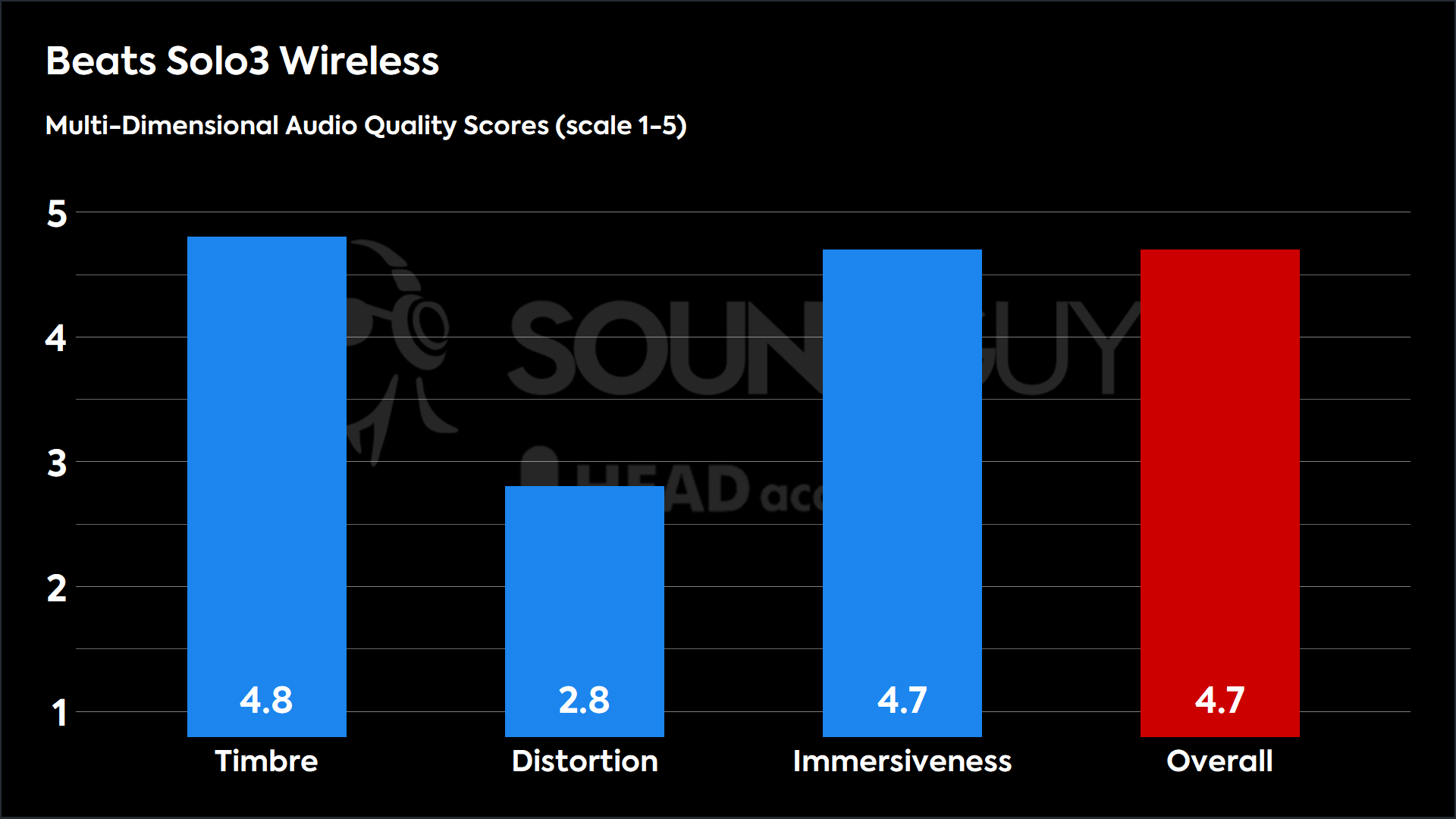
Because the Beats Solo3 Wireless is so bassy, we’re not surprised to see it score so well in Timbre and Immersiveness. Overall, this leads to a rock solid score of 4.7, even if the distortion is a little on the unpleasant side. Most people won’t notice this, but it is worth noting that you might pick up on some weirdness when you’re in perfectly quiet situations.
- Timbre (MOS-T) represents how faithfully the headphones reproduce the frequency spectrum and temporal resolution (timing information).
- Distortion (MOS-D) represents non-linearities and added noise: higher scores mean cleaner reproduction.
- Immersiveness (MOS-I) represents perceived source width and positioning: how well virtual sound sources are defined in three-dimensional space.
Reviewer’s notes
The Beats Solo3 Wireless has a less emphatic bass response than other Beats products — but given the history here that’s not saying a lot. Yes, low notes are amplified over mids and treble, but not so much so as to completely degrade audio quality. The relatively gentle bass emphasis can’t make up for the fact that the dynamic drivers appear to under-emphasize treble frequencies quite a bit if you can’t get a good fit. This can make it hard to hear the nuances of an, especially during a cacophonous musical section (e.g., the bridge in any Dave Matthews Band song). If you like hip-hop and pop, this is the sound for you.
Yes, if you own an Apple device, you can listen to Spatial Audio on the Beats Solo3 Wireless. Keep in mind you’ll only hear Spatial Audio on content mixed for Dolby Atmos or other spatialization software, so this feature works best for users who subscribe to Apple Music.
Midrange clarity fairly poor; Generator ^ Second Floor by Freelance Whales really showcases this issue when the consistent drum kicks come in about 40 seconds into the song. Other parts of the song become hard to hear as the bass kicks start and the banjo all but disappears. Even the vocals are hard to hear until the bass kicks drop out of the song.
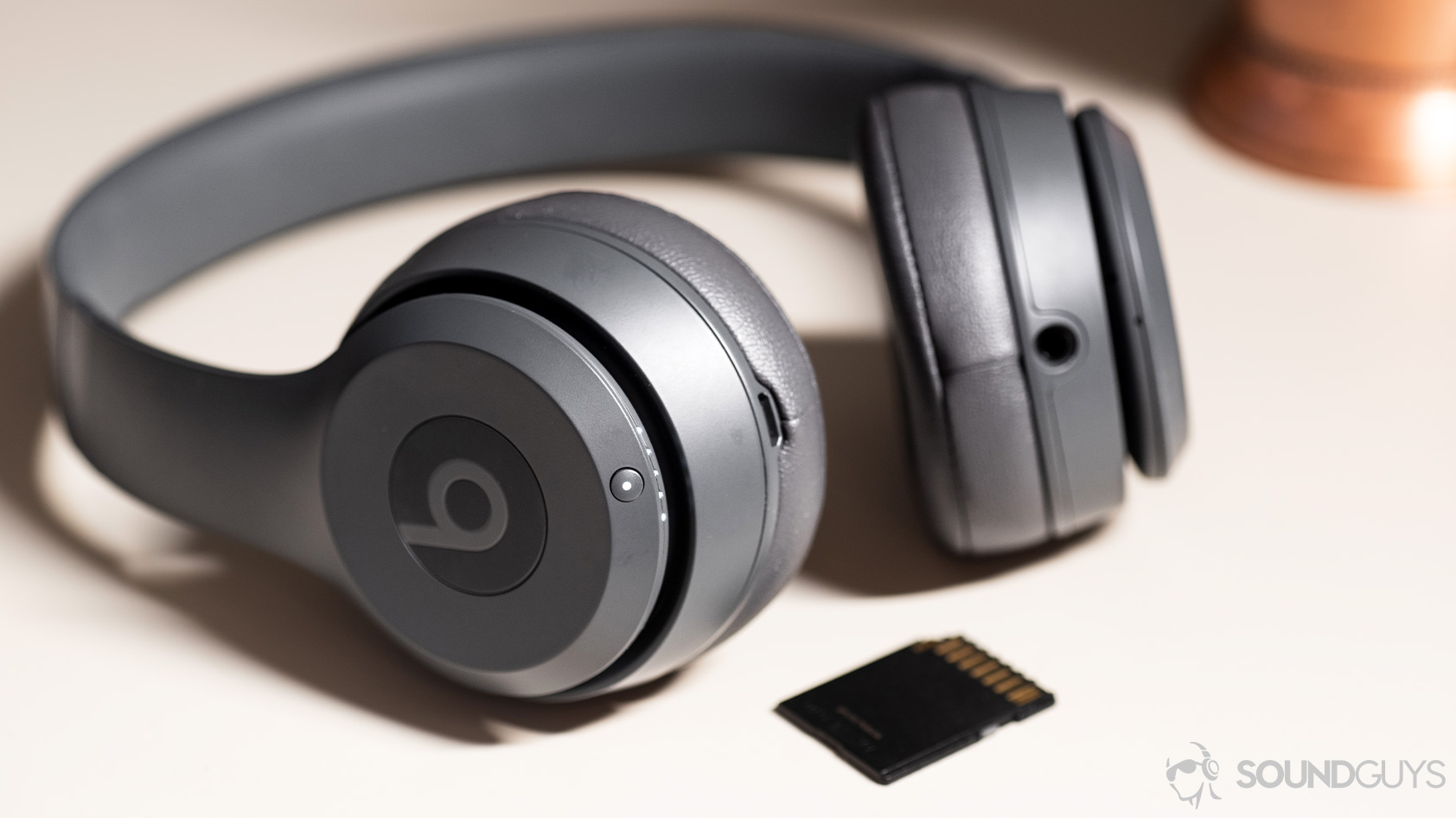
The upside of the quiet treble is that listeners are less likely to suffer from “listening fatigue” due to loud, high-pitched frequency reproduction. The finger-pick scratches in Naked As We Came by Iron & Wine can lend a nice live feel to the song but often make me feel uncomfortable through other consumer headsets. Yet, the “scrape” sound is barely noticeable with the Solo3 Wireless.
Sound leakage is pretty real with this pair of headphones, though. If you’re listening with the volume above 60%, the people next to you will probably be able to sing along.
Objective Measurements
Loading chart ...
The Beats Solo3 Wireless have a very strong bass emphasis all the way up to about 500Hz, before the mids chill out a bit and the response stabilizes. Though the highs are a little over-emphasized compared to what we like to see, the difficulty of getting a good fit means that there’s no guarantee that what’s on this chart is what you’ll hear. It’s entirely possible that this level of treble isn’t what makes it to your eardrums.
Moving the headphones on the head can lead to a change in the bass and highs, depending on whether you get a seal or not. If you bust the seal — very easy to do with on-ears — you can expect poorer bass. If this happens, the treble might appear louder than it actually should in comparison to the bass.
Can you use the Beats Solo3 Wireless for phone calls?
The microphone of the Beats Solo3 Wireless isn’t terrible, but it’s definitely not something you’re going to be recording a Billboard top 100 hit on. This is needs-suiting, but you may want to listen to the samples below in order to figure out if you want this.
Beats Solo3 Wireless microphone demo (Ideal conditions):
How do these sound to you?
Beats Solo3 Wireless microphone demo (Office conditions):
Beats Solo3 Wireless microphone demo (Street conditions):
Beats Solo3 Wireless microphone demo (Windy conditions):
Beats Solo3 Wireless microphone demo (Reverberant space):
Should you get the Beats Solo3 Wireless?
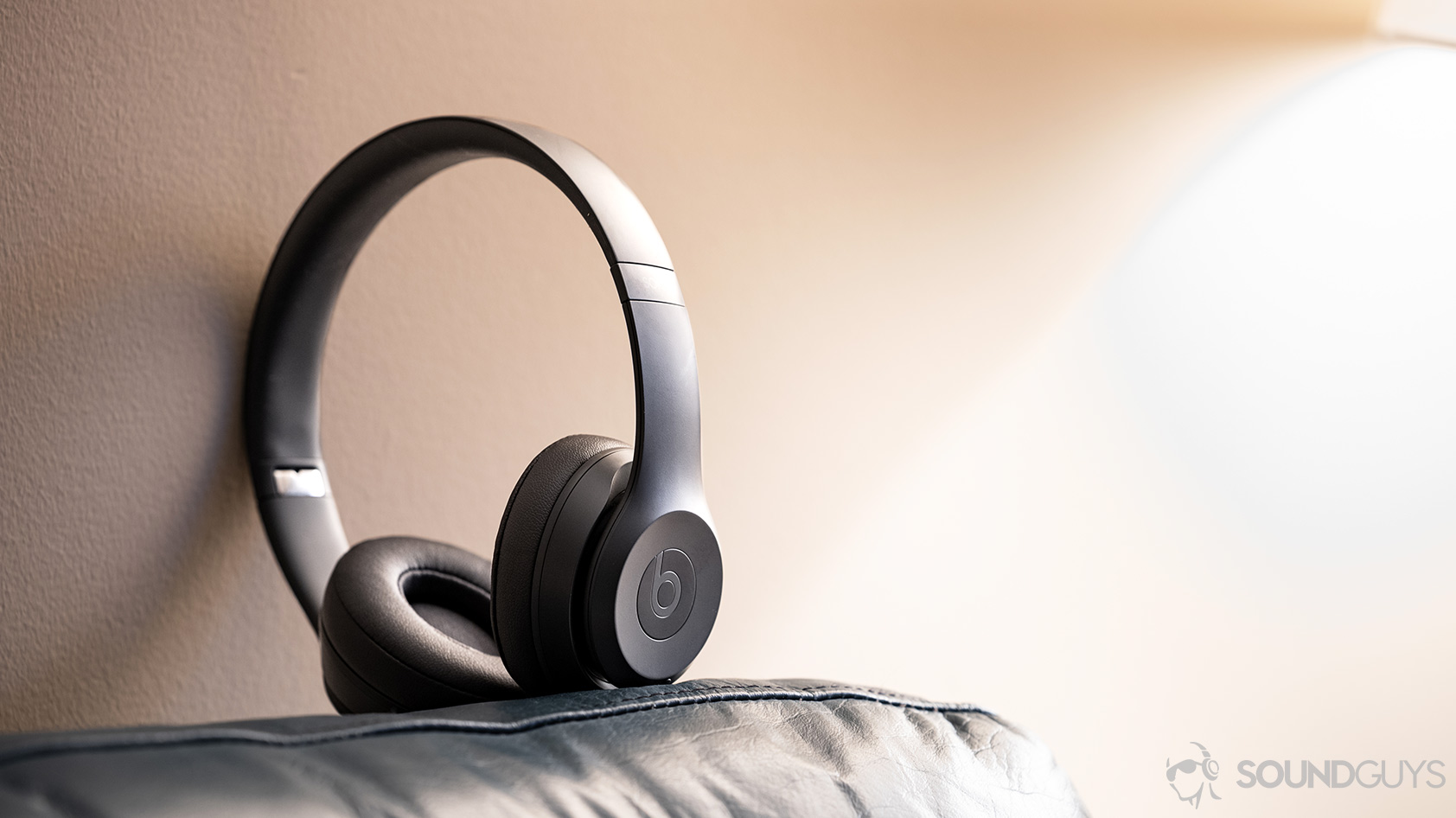
Initially, the Solo3 Wireless was an exciting headset that had unique features that let you easily connect to an iOS device, thanks to the W1 chip. Today, this feature isn’t novel; rather, it’s expected, and there are other, more comfortable on-ear headphones around. That said, the Beats Solo3 Wireless is still a fine option, but just not worth its original price.
If you do decide to go with this headset, you’ll still get important features like top-notch battery life, great Bluetooth connection with AAC support, and quick charging, all in an attractive, portable form factor.

Beats Solo3 Wireless vs Beats Studio 3: Which is the better on-ear headphones?
![Beats Studio3 Wireless[6] Curiously, there's no USB Type-C or even a lightning port on the Beats Studio3 Wireless.](https://www.soundguys.com/wp-content/uploads/2018/02/Beats-Studio3-Wireless6.jpg)
If you want to stay with the Beats brand, the Studio3 Wireless has about the same build quality and design as the Solo3. What might tip you over to the Studio3, however, is the fact it has noise canceling. The ANC is fine, though not great, but combined with decent isolation, you get an overall listening experience that blocks out some distracting sounds — especially at higher frequencies. You still get the W1 chip and only SBC and AAC Bluetooth codec options, but there’s the option of using a 3.5mm wired connection, too.
What are some alternatives to the Beats Solo3 Wireless?
If you want to stay within the Apple ecosystem and get premium ANC performance, we recommend the AirPods Max. That said, the AirPods Max costs $549 USD and is pretty cost-prohibitive for most, but if you have the money, you’ll enjoy seamless device switching, great sound quality, Apple Spatial Audio with head tracking, and more. The build quality is a huge step up from the Beats Solo3 Wireless, as it should be, and you get grade-A active noise canceling that outperforms the Bose flagship headset and rivals Sony’s.
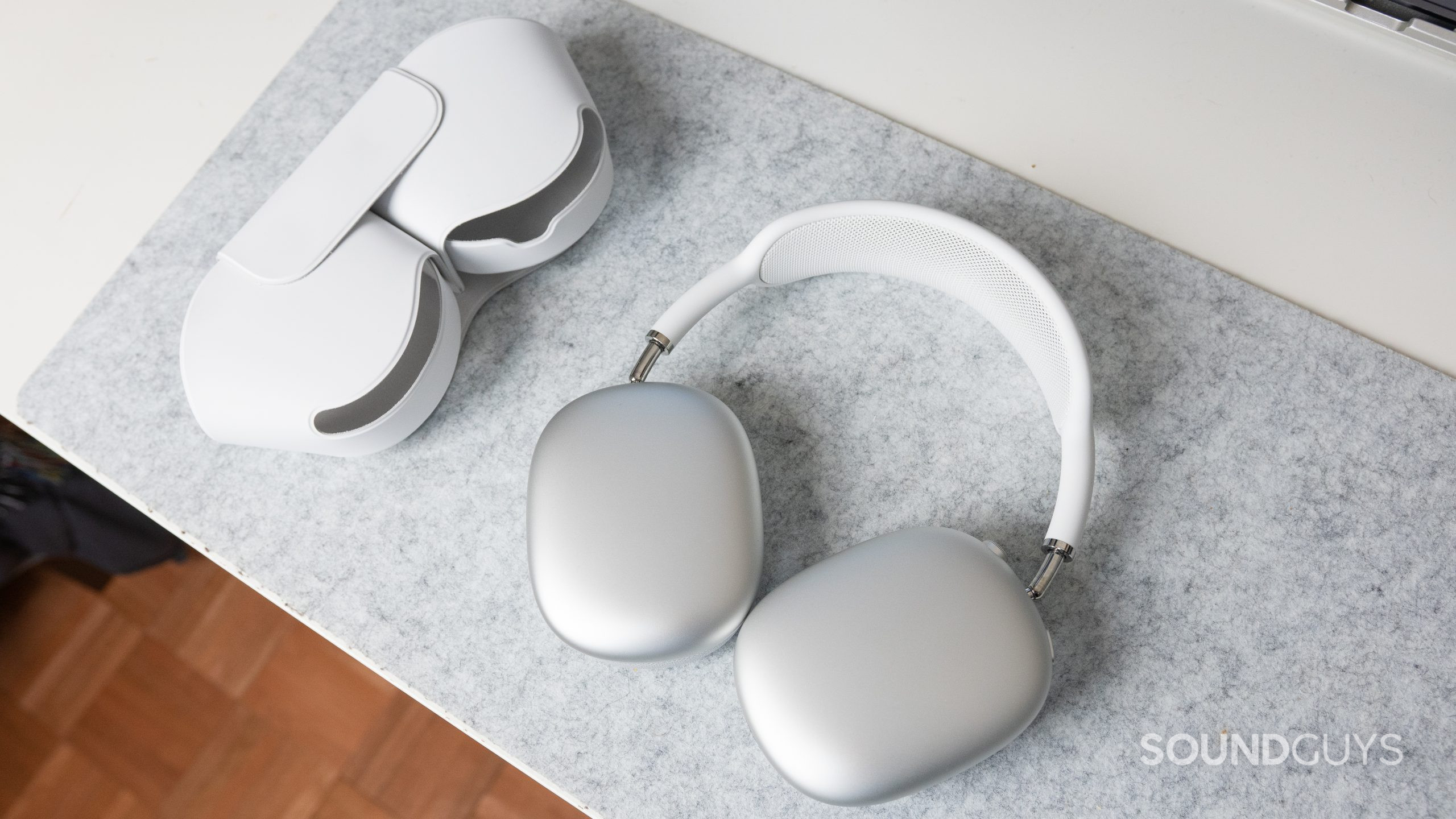
Another noise canceling option to consider is the JBL Tune 660NC. This set of cans retains the on-ear design while providing ANC and a lightweight build. They could start to feel tight and pinchy for some people, but if you insist upon an on-ear design, they’ll fit that use case nicely. Plus, they’re definitely far cheaper than the AirPods Max.
There are headphones in the $200 USD and below range available with better audio quality and greater comfort. One of our favorites is the Jabra Elite 45h. These headphones last over 54 hours and support Bluetooth multipoint. This means you can connect to two devices at a time. Another option for listeners who are rough with their gear is the V-MODA XS headset. These are MIL-STD 810G tested, meaning they can withstand a whole lot before breaking. Unlike the Beats Solo3 Wireless, the headband can be bent every which way, and if you do come across any issues, V-Moda has a stellar warranty program.
What are some more portable alternatives to the Solo3 Wireless?
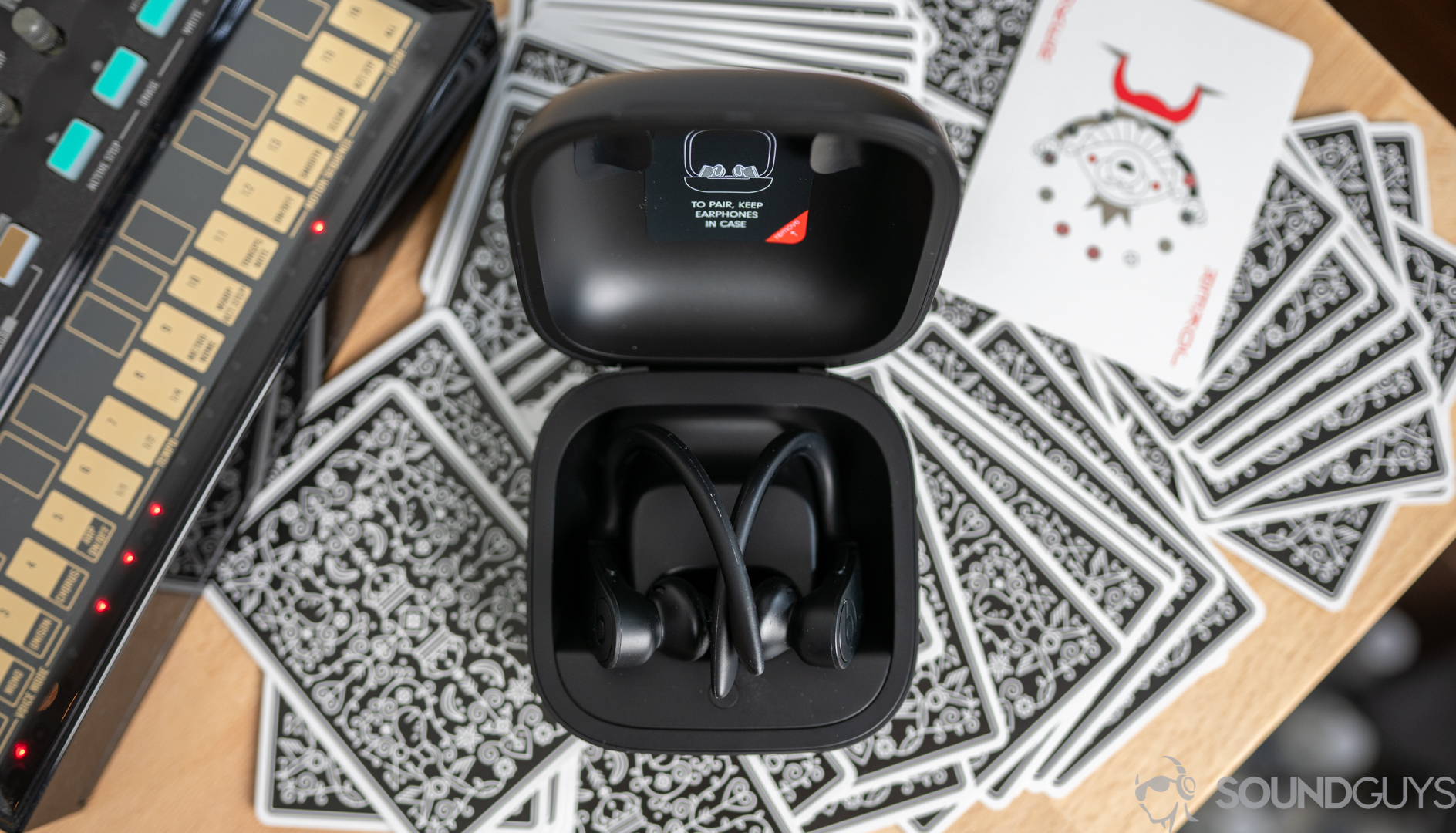
If you’re interested in the Beats Solo3 Wireless to the gym, then you might want to check out the PowerBeats Pro instead. The Powerbeats Pro is designed for athletes and has ear hooks that keep the buds in place. You can exercise without issue, knowing that the buds have an IPX4 certification that protects them against sweat. Battery life is exceptionally good and lasts more than 10 hours on a single charge. The Beats Fit Pro is a more compact option with noise canceling, but we have trouble recommending the Fit Pro due to its known ANC performance issues. There’s also the Beats Studio Buds, which checks all the same boxes as the Fit Pro but with a more low-profile design.
Considering that the Beats Solo3 Wireless headphones are still going for about $200 USD, we’d be doing you a disservice if we didn’t point out that at that price range, you’re not too far off from the price tag of the AirPods Pro. The AirPods Pro earbuds are much smaller and improved from the standard AirPods. The AirPods Pro is great for working out thanks to the IPX4 rating, and frequent flyers will appreciate the solid active noise canceling.
Frequently asked questions about the Beats Solo3 Wireless
In 2024, the Beats Solo3 are still available for purchase and are sticking around for the foreseeable future. The Beats Solo Pro, however, is being discontinued.
Yes! The Beats Solo3 Wireless comes with an included 3.5mm headphone connector, so you can use the headset either wired or wirelessly.
The Beats Solo3 Wireless can connect to pretty much any Bluetooth device, although if your device uses an older version of Bluetooth, the range and connectivity may not be as good. The Beats Solo3 Wireless features Class 1 Bluetooth, which means it can theoretically connect to devices at a range of hundreds of meters.